The bamboo plant is grass, but wood is strong enough to be used for furniture and flooring. Since Bamboo grows quickly and clumps can be dense enough to provide curtain-like foliage, Bamboo is usually grown in gardens for its ornamental aspect or as a privacy tree. After considering it exotic, gardeners consider Bamboo a versatile and robust addition to the home garden. Bamboo growth is fast and thick and can quickly add a lovely and lush feature to the garden in no time. Furthermore, bamboo plants require little maintenance.
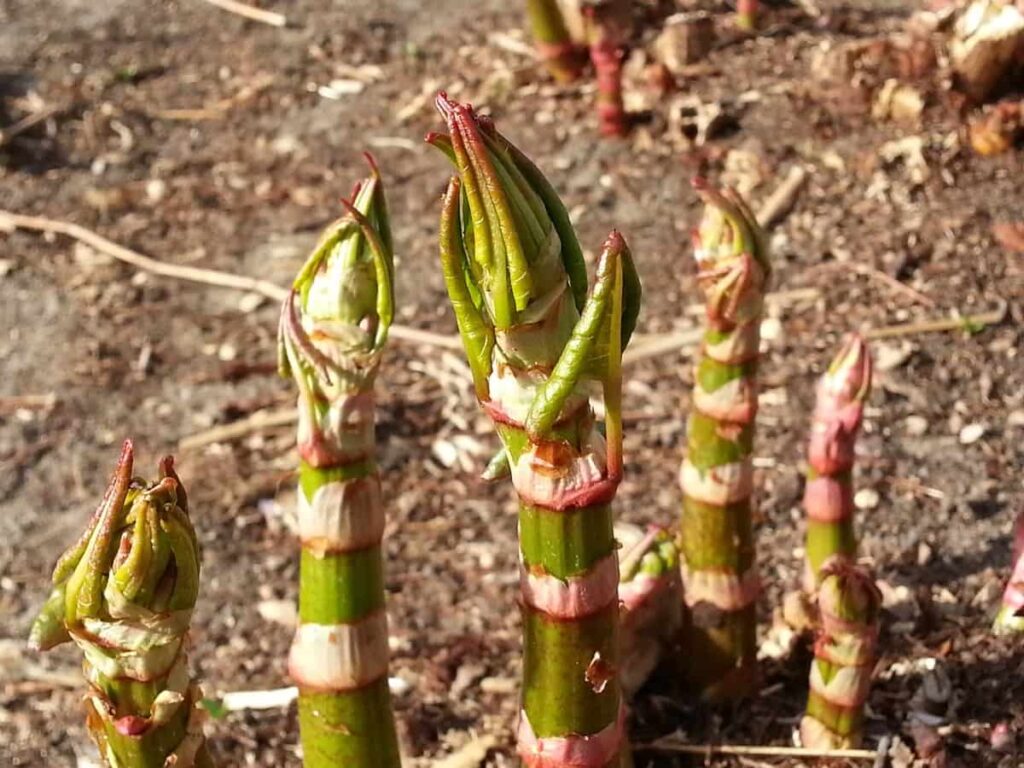
Evergreen perennials with woody stems are considered among the world’s fastest-growing plants. The growth rate of some kinds can reach one foot per day. Its fast growth makes it an extremely sustainable resource, and eco-friendly bamboo products, such as utensils, toothbrushes, and home goods, are becoming increasingly popular. Bamboo can be as small as 4-6 inches or as large as 130 feet. Several varieties within that broad range are suitable for landscape use. Some plants can grow so fast and densely that they crowd out others.
How to design a Bamboo garden
Types of Bamboo plants
Running Bamboo and clumping Bamboo are the two types you need to note. All bamboos have rhizomes or stem-like extensions that sprout roots and run underground. While clumping Bamboo have shorter rhizomes that don’t stray far from their origin, running Bamboo has long rhizomes that spread horizontally. Root pruning should be done annually to control running types since they need a large area to spread.
They will quickly dominate the garden landscape if they are not controlled. A clumping type is more chill. They form tight clusters of shoots that grow outward from a central plant at a much milder pace of 2-12 inches per year. Depending on the type of Bamboo, sunlight requirements vary, but all bamboos are satisfied with regular watering. Until new plants are established, they must be watered once daily. Then, if you want the best results, add a 2- to 3-inch layer of compost, mulch, or organic matter.
Typically, clumping bamboos prefer shade or part shade and come in various colors and sizes. It is also possible to prune them into any shape you like without harming the plant. The outer canes of a clump can be thinned or removed at ground level if it grows too wide, for instance. In addition, cut dwarf or ground-cover Bamboo back to the ground every spring to maintain their health. As the new growth grows, it becomes thicker and shorter.
Common clumping varieties used for landscaping
Alphonse Karr Bamboo
Suitable to use in garden beds, pots, and troughs, Alphonse Karr is a small golden bamboo that makes an attractive ornamental feature or a light privacy screen. It has attractive bushy green foliage with green and gold striped culms. The height of Alphonse Karr is naturally between 3 and 4 meters.
In case you missed it: How to Create a Potager: A Full Guide to French Kitchen Garden
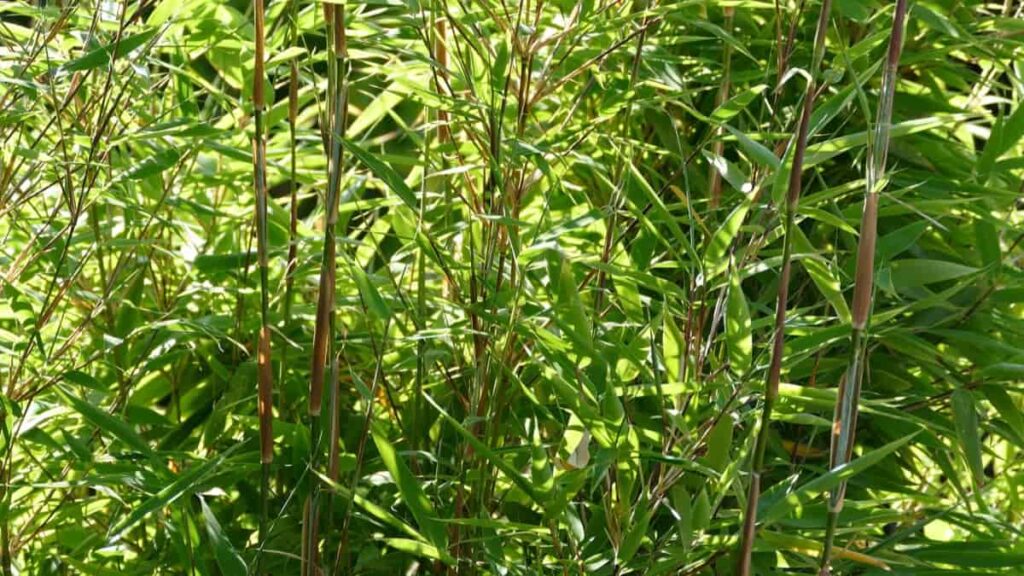
Giant Buddha’s belly Bamboo
Nothing is more famous than the giant Buddha’s bellies regarding ornamental Bamboo, which is famous for its bulging nodes on their culms. Long, narrow green leaves characterize this bamboo type. It can naturally grow up to 6-8 meters in height, but it can be trimmed down if necessary. The arching shape of this Bamboo is important to preserve, so trimming it too short could cause it to lose its integrity.
Murray Island Bamboo
Its lush top growth also makes it an ideal privacy screen as it forms dense clumps with lighter green, textured leaves. The plant can reach a height of 13 feet.
Chinese dwarf Bamboo
Chinese dwarf Bamboo can also grow up to nine feet tall, making it a popular hedge choice. Chinese dwarf Bamboo is a lush, bushy bamboo that makes a beautiful, compact privacy screen, pot plant, or garden feature. This Bamboo has a graceful appearance because it is naturally bushy down to the ground. A neater appearance can be achieved by removing the lower branches.
Timor Black Bamboo
The leaves of this clumping form of black Bamboo are light green, and the culms have dark stripes in lighter colors. The plant can reach a height of 50 feet. Timor black is one of the most popular black clumping species and forms a striking screen of glossy black culms and light green foliage. It can be managed if kept in confined planter beds or pots, although it is better suited to medium-sized gardens.
Golden goddess Bamboo
The Golden Goddess is also commonly used as a privacy screen or to mark borders and perimeters. This plant grows to a height of about 10 feet. For compact, upright screens, this variety is the ideal clumping bamboo. Even though it will grow in very narrow beds only 40cm wide, it prefers a bed at least 1m wide. The culms are beautifully ornamental with green and gold stripes when pruned back.
Black Bamboo
Black Bamboo is a beautiful addition to any home garden, known for its olive green upright canes. In a few years, these Bamboo will become completely black. They will assume a brownish marble hue almost immediately. In addition to their multicolored hue, each of these canes goes through phases of color development. There is a perfectly smooth and slimy surface to the canes, around two inches wide.
In case you missed it: Missouri Vegetable Planting Calendar (MO): Month-wise Chart, Schedule, and Guide for Zone 5, Zone 6, and Zone 7
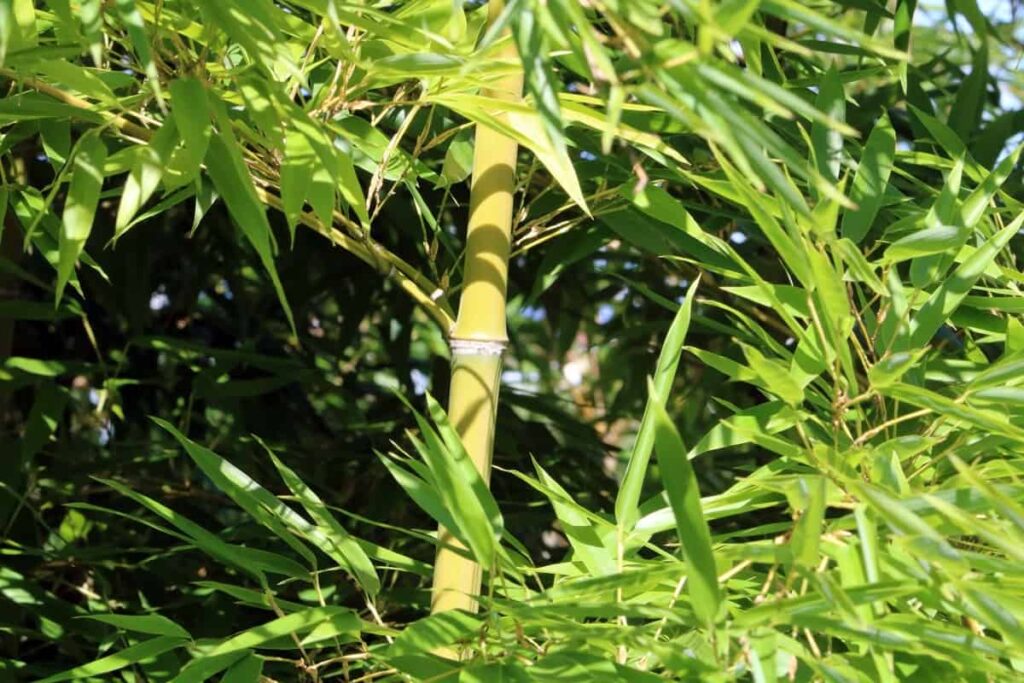
Choosing a location for Bamboo plants
A bamboo plant can grow in various conditions; most species can adapt to different climates. Growing Bamboo in full sun, on the other hand, will result in the fastest growth. Most bamboo plants require at least 4 hours of filtered sunlight or better to thrive. Some Bamboo species prefer partially shady growing conditions, including those with large leaves and shorter canes, 20 feet or less.
However, this is not the norm for Bamboo. Bamboo plants are recommended to grow in fertile, slightly acidic, moist but well-drained soil. For the best bamboo growth, these conditions are ideal. It is still possible to grow bamboo plants if you meet a few of these conditions.
Spacing between Bamboo plants
Compound growth is characteristic of Bamboo. By starting with several bamboo divisions, you will be able to increase your bamboo production each year and make your privacy screen or grove in a shorter amount of time. Nevertheless, you can establish a bamboo grove with just one good division; it will just take longer.
You should plant on five-foot centers or closer if you wish to rapidly create a screen or grove. Within 3-5 years, this planting will be able to provide a screen. The larger your initial size, the taller your screen will be over time. A dense screen or grove will grow faster with closer spacing. Overplanting bamboo is not a good idea.
Planting Bamboo plants
Bamboo can be planted once you have selected a place to grow it. Make the hole double the size of the rootball of your Bamboo. In the hole, set the Bamboo and spread the roots out a bit. During the backfilling process, tamp down the soil a little to ensure it is compacted. Ensure that all air pockets are filled by watering the hole thoroughly.
By planting it this way, the Bamboo can establish faster since the soil around it will be loose, so its roots and rhizomes can grow more quickly. In the beginning, water the bamboo plants weekly until they establish themselves. It is recommended to provide shade to new bamboo plants for the first two weeks after planting them.
How to grow Bamboo from cuttings in water
- For Bamboo to grow from cuttings in water, cut several 10-inch long cuttings from a new growth with at least two nodes and two internodes. Once that’s done, cut the material at an angle of 45 degrees with a sharp knife.
- The ends of the cuttings should be dipped in melted wax. Keep the cuttings in a well-lit place for several weeks after placing them in water.
- Standing water quickly runs out of oxygen, so change the water every other day.
- Once the cuttings have two inches of roots, move them into a pot. A potting mix or a mixture of 1 part loam and 1 part sand will improve drainage. The cutting should be planted at a depth of 1 inch in the pot.
- Tie it to a stick with a string for support. This support will stabilize the bamboo cutting until it is established.
In case you missed it: USA Vegetable Planting Calendar: Month-wise Guide, Schedule, and Chart for All Zones
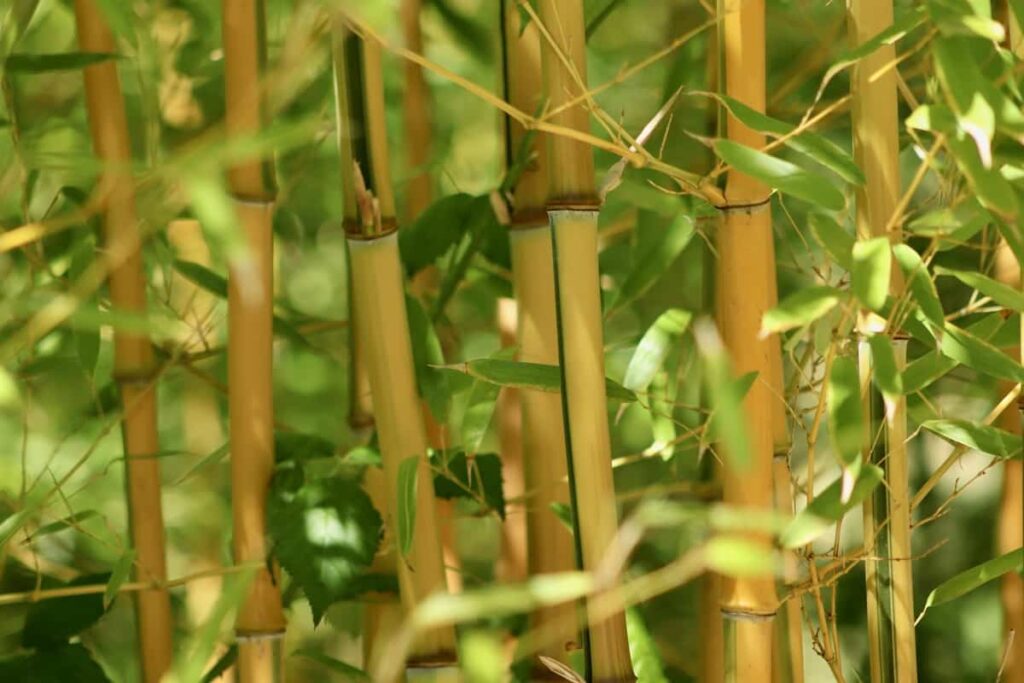
Growing Bamboo plants from rhizomes
- Divide bamboo rhizomes into portions using a gardening knife, leaving two or three growth buds per portion. Using rhizomes that are dark and patched will likely result in poor growth.
- Place bamboo rhizomes horizontally in pots with the buds facing up. Water thoroughly until it looks deeply moist after spreading a 3-inch layer of soil over them.
- Under a light shade, place the container in a warm spot. The soil should be maintained slightly moist at all times. Rhizome cuttings should not be overwatered; otherwise, they will rot.
- For rhizomes to grow, it will take between four and six weeks. You can plant them outside if the nighttime temperature stays around 13°C.
How to grow Bamboo from culm cuttings
- Cut a few cuttings from a three- or four-year-old bamboo plant with a hacksaw. Every section must have at least one node and at least one internode.
- Removing the leaves in between is the next step.
- Put potting mix or a mixture of coarse sand and loam in a pot.
- Ensure the first ridges of bamboo cuttings are sealed with wax, so they do not rot or dry out. The wax must be melted and dipped in about an eighth of an inch of water.
- Put two tablespoons of rooting hormone in a plastic bag and immerse the bamboo cuttings. The excess rooting hormone should be shaken off, and several holes should be made in the soil. Plant the cuttings carefully in them once they have been prepared.
- Cover the cuttings with a plastic sheet and place them in a warm, out-of-direct-sun area. Make sure the soil is kept moist by watering.
- You can tell that cuttings are forming roots when you see new shoots. As soon as the weather warms up, continue growing bamboo plants in containers or outdoors.
Caring for Bamboo Plants
It is pretty straightforward to care for bamboo plants once they are established. Whether it is rainfall or manual watering, Bamboo thrives when it receives at least one inch of water per week. In addition, Bamboo will be more drought resistant if it is watered deeply to encourage deep roots. Finally, don’t rake bamboo leaves up from bamboo roots if possible. By keeping the roots moist and protected, the leaves will help keep them healthy.
In addition to returning essential nutrients to the soil, they will also promote bamboo growth as they decompose. Bamboo roots will grow stronger if a layer of mulch is added. Bamboo can survive without fertilizer, but it can affect its growth and appearance. Therefore, fertilizers rich in nitrogen are ideal for Bamboo. Palm fertilizers will be effective in the subtropical clumping of Bamboo. Compost or balanced fertilizer should be applied in the spring as part of proper bamboo plant care.
In case you missed it: How to Grow Curry Leaf Plants Faster: Best Tips to Increase Yield
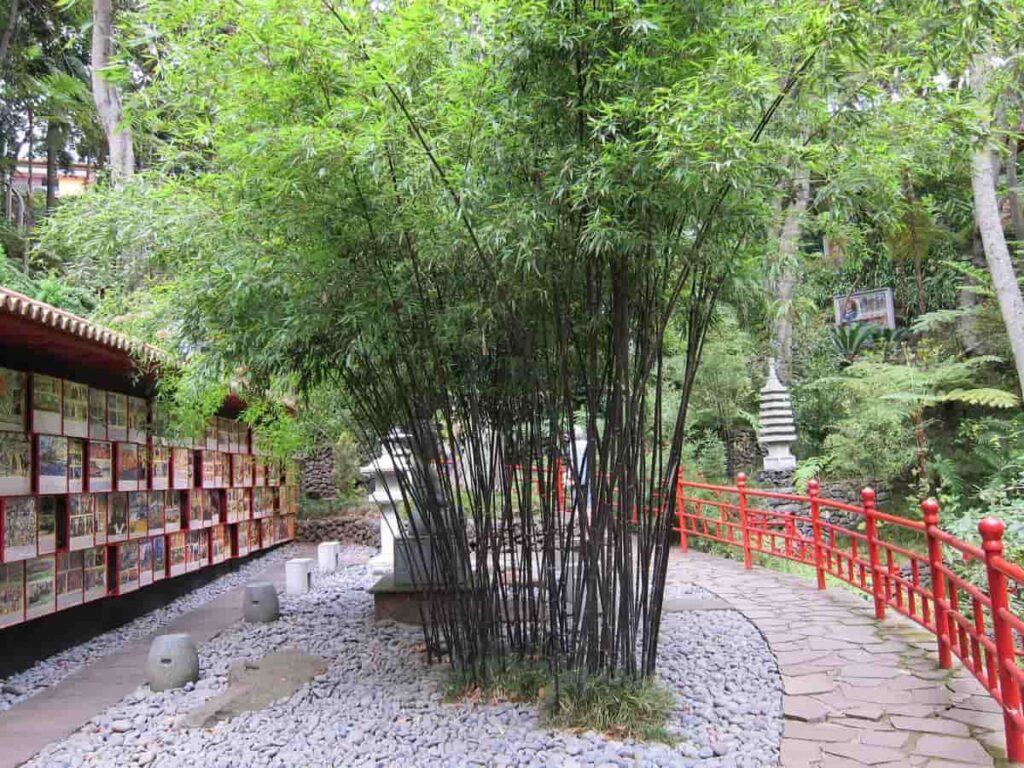
A sharp spade can remove errant rhizomes from the soil around the Bamboo to help control rhizome spread. The general rule of thumb is to root prune rhizomes about two feet from their parent plants. A bamboo’s type and personal preference determine how often it needs to be pruned. When removed, canes should be cut as close to the ground as possible. Do not prune out more than one-third of the canes for the best results yearly.
How Bamboo plants are used in landscaping
Due to its versatility and quick growth, Bamboo is a natural choice for a variety of landscape applications, including,
Privacy screens
The most common application for natural bamboo screens is in backyards because they can be trimmed to desired heights and widths and grow faster and taller than shrubs and hedges. The most popular bamboo species for this purpose are Golden Bamboo and Dwarf Malay clumping varieties. However, clumping Bamboo is not as tall as the more invasive running Bamboo, which is a drawback for landscape gardeners.
Windbreaks
Bamboo is often used to construct windbreaks in many parts of the world. The flexibility of Bamboo makes it ideal for use as a windbreak in typhoon-prone areas and tropical locales experiencing heavy winds. In addition, due to its ground-stabilizing root mass and low risk of falling branches, some people believe Bamboo can provide refuge during an earthquake.
Hedges
When privacy is not an issue, Bamboo makes pretty hedges. Bamboo can be maintained as a sheared hedge for a more decorative landscaping effect. In addition to reaching a height of 15 feet, Robusta is well suited to medium-high compact hedges. Alternatively, if your objective is to keep this variety at a low height, you can prune it to maintain that height. Chishima Zasa is a good choice for smaller hedges.
Ground cover
It is possible to grow several types of Bamboo in many different colors and heights, making it a unique ground cover option. Bamboo varieties that grow under 10 feet are considered ground-cover varieties. These Bamboo ground covers can be used for erosion control in challenging locations, such as steep hillsides or banks. Chino Elegant and Indocalamus Solidus are popular ground cover options.
Controlling Bamboo plant growth
Bamboo can grow too much in a yard sometimes. The first thing to do is to find out how aggressive a particular variety of Bamboo is. Bamboo clumps that are vigorously growing, such as running Bamboo, should be planted in a barrier or installed in a barrier if they are already established. Ideally, the barrier should go down at least 2 inches underground and be 2 to 3 inches above the ground.
A barrier should surround them to protect the bamboo plants. Ensure the barrier’s top is checked at least once a year after installation. If Bamboo is growing over the barrier, cut it back to prevent it from escaping. It is almost carefree to grow bamboo plants, especially if you choose the clumping variety instead of the running, more invasive variety.
In case you missed it: How to Propagate Peace Lily: Flowering Stages, Planting, Growing, and Care for Indoors and Outdoors
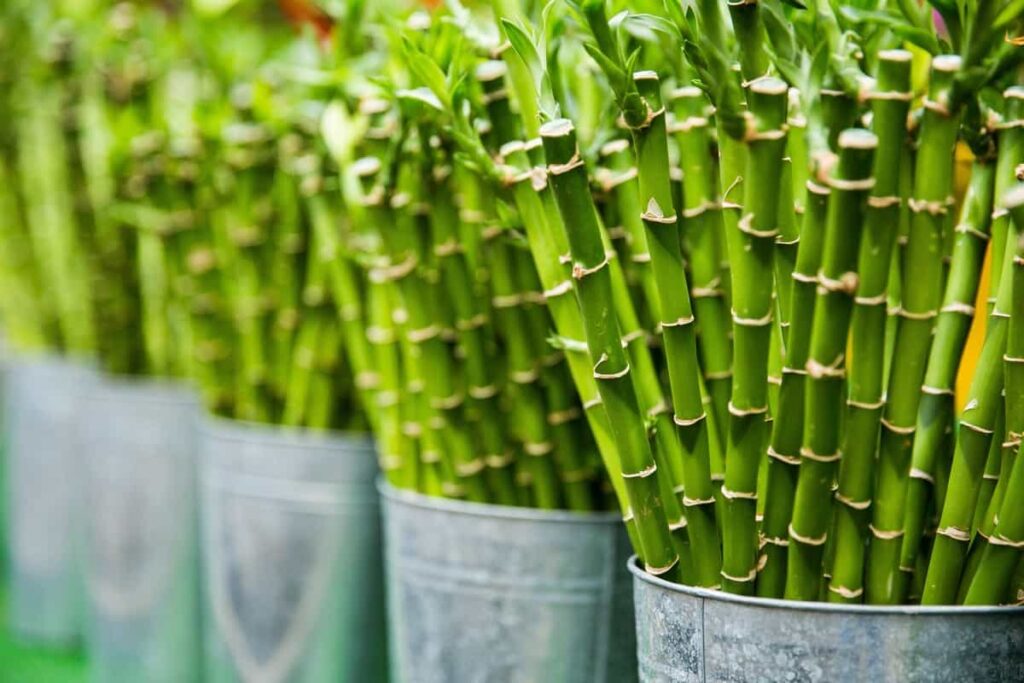
How long do Bamboo plants live
Bamboo plants can last for more than a hundred years. Depending on the species, canes can live up to 15 years, but 7 to 10 years are more common. Due to the lack of sunlight, the starter and smaller plants will die off more rapidly as the grove matures.
Conclusion
The fast growth and architectural stems of Bamboo make them a popular garden plant. While some bamboos are perfect for tropical planting schemes, others are better suited to contemporary or urban settings. Natural screening can be achieved with some clump-forming species.
There are many varieties of bamboo plants, ranging from black to yellow. Plants like this are remarkable for their rapid growth and can play an important role in reducing pollution and improving soil quality. Furthermore, bamboo plants make your garden beautiful and provide biofuel, food, and architectural and construction applications.
- Crops Grown in Summer Season: Best Choices for Summer Gardening
- Organic Pest Control for Tomato Farming
- How to Maximize Sheep Farming Profit
- Broccoli Varieties: Choosing the Right Cultivars for Your Farm
- How to Raise Pigs in Your Own Backyard: A Comprehensive Guide
- Budget Friendly Sheep Shed Ideas: Cheap and Low-Cost Tips
- How Much Do Cattle Farmers Make: Revenue Streams in Cattle Farming
- Management Pests and Diseases in Your Cotton Field
- Sheep Farming Business Plan for Beginners
- Aquaponic Farming at Home: A Step-By-Step Guide
- Profitable Village Farming Business Ideas in 2024
- High-Yield Aquaculture: Fast-Growing Fish for Farming
- Effective Fish Pond Construction Techniques for Beginners
- Irrigation and Water Management in Pineapple Farming
- Blossom to Harvest: Mastering Flowering and Pollination in Papaya Farming
- Pig Fattening Essentials: From Selection to Sale for Beginners
- Raising Wagyu Cattle: A Complete Guide for Premium Beef Production
- Soil Types and Their Water Holding Capacity
- Optimizing Irrigation Schedules for Coconut Groves for Enhanced Yield
- Espresso Your Garden: Coffee Grounds for Healthier Acid-Loving Plants
- The Best Soil Mix for Snake Plants: How to Mix Your Own Snake Plant Soil
- Green Thumb Success: Expert Tips for Cultivating Greenhouse Beans All Year Round
- Bloom All Year Round: The Ultimate Guide to Indoor Hyacinth Care
- Eco-Friendly Gardening: How to Make Liquid Fertilizer from Kitchen Waste
- Ultimate Guide to Grow Anise in Pots: Explore Seed Propagation to Harvesting
- Guide to Raising Chester White Pigs: Discover Breed Facts to Growth Management
- Mastering the Elegance: The Ultimate Guide to Weeping Cherry Tree Care, Planting, and Maintenance
- Ultimate Guide to Planting Garlic in Grow Bags: Growing Strategies for Beginners
- How to Fix Spider Plant Leaf-Related Problems: Natural and Organic Remedies
- 10 Reasons Why Your Tulsi Plant is Shedding Leaves: Home Remedies and Solutions
- Optimizing Growth and Yield: The Advantages of Palm Bunch Ash Fertilizer
- Utilizing Neem Oil Extract as a Natural Pesticide for Hydrangea
- From Soil to Harvest: Various Ways in Which Farmers Can Use AI Tools
- Steps to Encourage and Induce Citrus Flowers: A Comprehensive Guide
- How to Fix Snake Plant Leaf-Related Issues: Natural and Organic Remedies
- Transform Your Garden into a Fragrant Oasis with Raat Ki Rani (Night Blooming Jasmine)

Picking a good bamboo plant location feels like a really important thing to get right. If I don’t have the right place for that, the shoots might start getting malnourished and they could die quite quickly. I’ll think about this and prepare the location first before I go to a local bamboo nursery and take my first shoots.